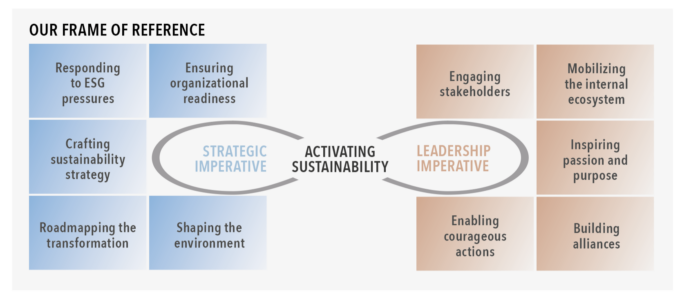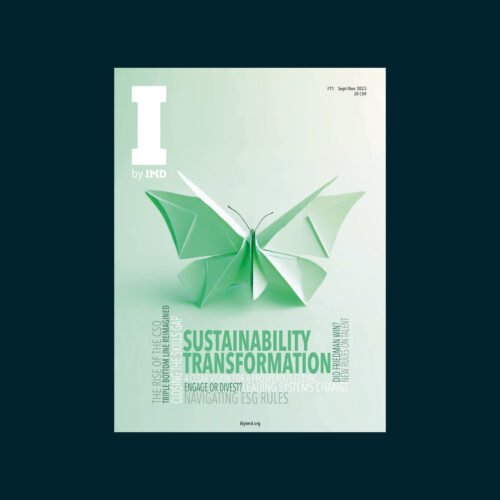
Europe needs Chips Act 2.0 to compete in digital race
Former French finance minister Bruno Le Maire says Europe needs to act urgently to secure its supply of semiconductors or face relegation to the global slow lane. ...
Audio available

by James E. Henderson, Julia Binder, Knut Haanaes Published September 18, 2023 in Sustainability • 6 min read
Why do most business transformation initiatives fail? Often, organizations focus only on the strategic reasons for change and ignore the leadership and change elements of how the transformation is to be delivered. While business leaders are usually clear on the logic of sustainable transformation, they often fail to create the engagement needed to drive the change they want to achieve.
All these elements are essential for any kind of transformation to succeed. You need a combination of the head, or the logic of transformation, and the heart and hands, or the leadership of transformation, to get your organization to mobilize around the change. And this is particularly true when it comes to sustainability, which requires fundamental transformation for most companies.
Strategists in many organizations tend to focus on the factual rationale for innovation and change, but this approach ignores the vital importance of the need to bring people along with you, both inside the organization and in the external ecosystem. And yet it is this leadership part of the equation that really drives change. Both elements need to be combined if businesses are going to play a full part in shaping the future and creating a more sustainable world.
When organizations concentrate only on the strategic side of the picture, the transformation initiative tends to happen in a vacuum, with an expectation that change will happen automatically once the initiative is announced, but research shows that this rarely happens in reality. Such an approach misses out a whole range of actions needed to ensure that people are inspired to get behind the initiative.

From linear to circular – unlock sustainable business opportunities
Yet, focusing only on the leadership aspects of transformation will not work if the strategic imperative for change is not present. Take the example of the aviation sector, where some organizations are making a push to adopt sustainable aviation fuels, even though these are still up to five times the price of regular aviation fuels. Even if you deploy all of the leadership tools at your disposal, any change is going to be limited and very slow until the underlying production technologies improve so that sustainable aviation fuels become more cost competitive.
Recent academic research showed the importance of the two – clarity in direction (the head) and corporate purpose (the heart and hands) – for financial performance. Using data from the Great Place to Work Institute’s surveys, the authors found that those companies that were rated “high” by their middle management and salaried employees on both corporate purpose and clarity in direction achieve a significant improvement in financial performance over time. However, the authors were unclear about the causal mechanisms behind this process. We decided to shed some light on the forces at play and explain how they operate in the area of sustainability.

Our model for leading sustainable business transformation takes the form of an infinity loop showing how the strategic and leadership aspects of driving change intertwine and interact. Sustainability is a constantly changing area and so there is a continuous cycle in which developments on one side of the model flow through to adjustments on the other.
We developed this infinity loop model specifically for our Leading Sustainable Business Transformation program. It is constantly evolving, but we think that it provides a useful frame of reference for starting to think about the key components of successful sustainable business transformation, in which companies build advantages and shape the future through new business models.
Let us explain a bit more about each of the elements of the model. On the strategic side, the important components are as follows:

No organization can escape the need to transform to become more sustainable. The need to act is urgent. It calls for strong leadership, difficult decisions, and deep cultural change.
In the September issue of I by IMD, we explore how to build sustainable organizations to succeed in turbulent times.
And on the leadership side, the key dimensions are:
We hope that this model can serve as a useful framework for the actions needed to deliver sustainable business transformation, and help organizations move from the “what” to the “how”. Executives understand the logic of sustainability and why it is necessary, but they often struggle to understand how to go about the transformation.
The nature of the challenge and the scale of change needed will differ between companies, but all organizations have to undertake some form of transformation, and they can use this frame of reference to help them identify what they need to do.

Professor of Strategic Management at IMD
James E. Henderson is Professor of Strategic Management at IMD, Program Co-Director of the Leading Sustainable Business Transformation program, and Program Director of the Strategic Partnership course. He helps companies achieve and sustain their competitive advantage either at a business unit, corporate, or global level through directing custom specific executive programs, facilitating strategy workshops, or teaching MBAs and executives.

Professor of Sustainable innovation and Business Transformation at IMD
Julia Binder, Professor of Sustainable Innovation and Business Transformation, is a renowned thought leader recognized on the 2022 Thinkers50 Radar list for her work at the intersection of sustainability and innovation. As Director of IMD’s Center for Sustainable and Inclusive Business, Binder is dedicated to leveraging IMD’s diverse expertise on sustainability topics to guide business leaders in discovering innovative solutions to contemporary challenges. At IMD, Binder serves as Program Director for Creating Value in the Circular Economy and teaches in key open programs including the Advanced Management Program (AMP), Transition to Business Leadership (TBL), TransformTech (TT), and Leading Sustainable Business Transformation (LSBT). She is involved in the school’s EMBA and MBA programs, and contributes to IMD’s custom programs, crafting transformative learning journeys for clients globally.

Lundin Chair Professor of Sustainability at IMD
Knut Haanaes is a former Dean of the Global Leadership Institute at the World Economic Forum. He was previously a Senior Partner at the Boston Consulting Group and founded their first sustainability practice. At IMD he teaches in many of the key programs, including the MBA, and is Co-Director of the Leading Sustainable Business Transformation program (LSBT) and the Driving Sustainability from the Boardroom (DSB) program. His research interests are related to strategy, digital transformation, and sustainability.

From linear to circular – unlock sustainable business opportunities

July 10, 2025 • by Bruno Le Maire in Magazine
Former French finance minister Bruno Le Maire says Europe needs to act urgently to secure its supply of semiconductors or face relegation to the global slow lane. ...
 Audio available
Audio available
July 8, 2025 • by Mike Rosenberg in Magazine
A new framework encourages leaders to see the world as PLUTO – polarized, liquid, unilateral, tense, and omnirelational. It’s time to think differently and embrace stakeholder capitalism....
 Audio available
Audio available
July 3, 2025 • by Eric Quintane in Magazine
Entrepreneurial talent who work with other teams often run into trouble with their managers. Here are ways to get the most out of your ‘boundary spanners’...
 Audio available
Audio available
June 26, 2025 • by Michael Yaziji in Magazine
Forward-thinking leaders proactively shape their external environment, turn uncertainty into certainty, and create substantial value in the process....
 Audio available
Audio availableExplore first person business intelligence from top minds curated for a global executive audience